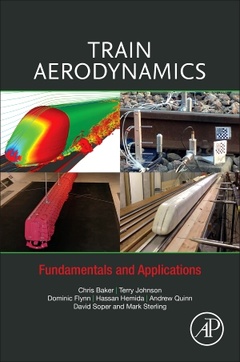Train Aerodynamics Fundamentals and Applications
Auteurs : Baker Chris, Johnson Terry, Flynn Dominic, Hemida Hassan, Quinn Andrew, Soper David, Sterling Mark

Train Aerodynamics: Fundamentals and Applications is the first reference to provide a comprehensive overview of train aerodynamics with full scale data results. With the most up-to-date information on recent advances and the possibilities of improvement in railway facilities, this book will benefit railway engineers, train operators, train manufacturers, infrastructure managers and researchers of train aerodynamics. As the subject of train aerodynamics has evolved slowly over the last few decades with train speeds gradually increasing, and as a result of increasing interest in new train types and high-speed lines, this book provides a timely resource on the topic.
Academics, postgraduate students that do research on Fluid Mechanics and or Applied Mathematics, + industry & agencies likely to be involved in planning high-speed lines. Also those involved in railway field for maintenance (both rolling stock and infrastructure), train operators, train manufacturers, and infrastructure managers.
After obtaining an MSc in Industrial Applied Mathematics in 1974, Terry Johnson initially worked as a research assistant at Sheffield Polytechnic. In 1977 he began his railway aerodynamics career as a graduate entrant to the Aerodynamics Team of British Rail Research in Derby. By the time of railway privatisation in 1996, he had risen to be Head of the Team. There followed 12 years working in the railway consultancies of AEA Technology Rail/DeltaRail. He then joined the Railway Safety and Standards Board in 2008 as their Principal Aerodynamics Engineer, and has worked on a wide range of railway aerodynamics research projects and has maintained and developed aerodynamic aspects in GB
- Examines the fundamentals and the state-of-the-art of train aerodynamics, beginning with experimental, numerical and analytical tools, and then thoroughly discussing the specific approaches in other sections
- Features the latest developments and progress in computational aerodynamics and experimental facilities
- Addresses problems relating to train aerodynamics, from the dimensioning of railway structures and trains, to risk analysis related to safety issues and maintenance
- Discusses basic flow patterns caused by bridges and embankments
Date de parution : 06-2019
Ouvrage de 402 p.
15x22.8 cm


